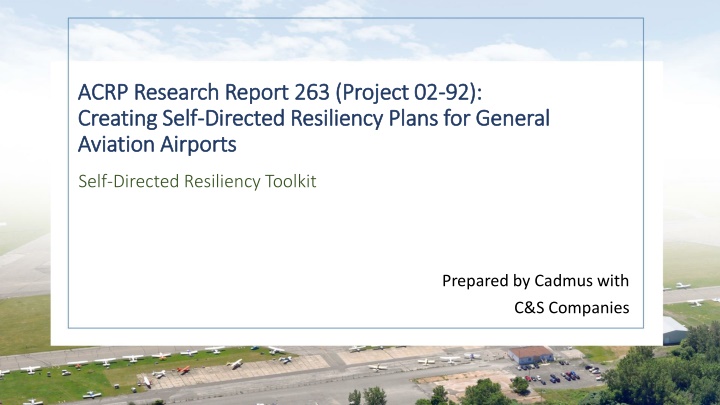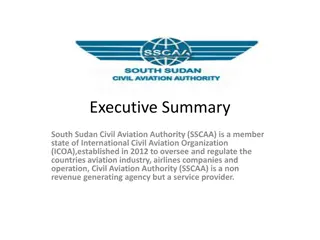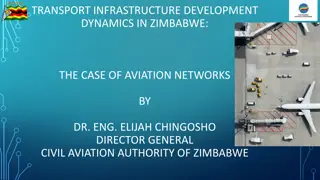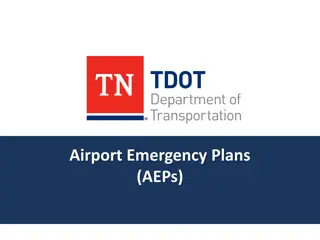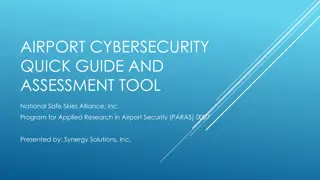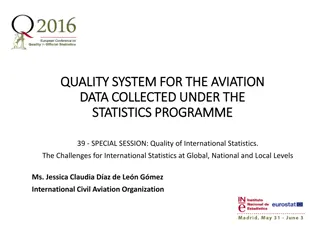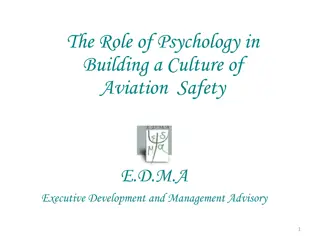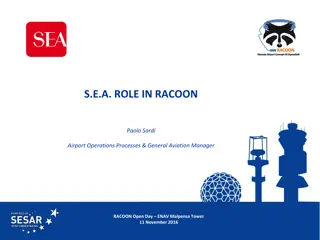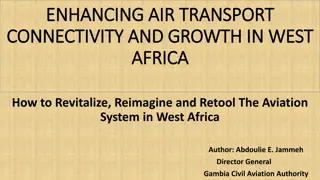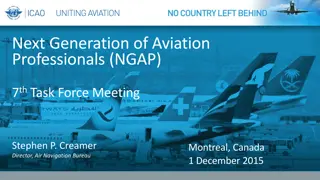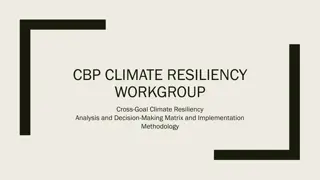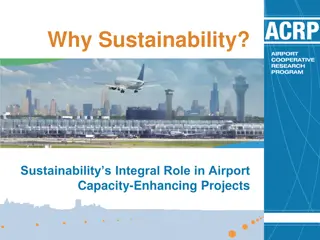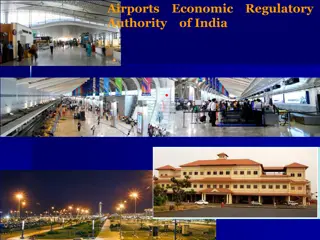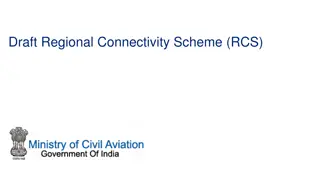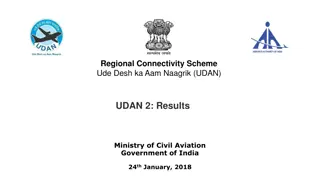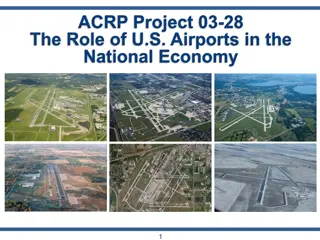Creating Self-Directed Resiliency Plans for General Aviation Airports
This toolkit empowers general aviation airports to enhance resilience in cost-effective ways, ensuring operational continuity and community service provision. GA airports play a vital role in disaster response and regional connectivity, making resilience crucial for their sustained functionality and economic impact.
Download Presentation

Please find below an Image/Link to download the presentation.
The content on the website is provided AS IS for your information and personal use only. It may not be sold, licensed, or shared on other websites without obtaining consent from the author.If you encounter any issues during the download, it is possible that the publisher has removed the file from their server.
You are allowed to download the files provided on this website for personal or commercial use, subject to the condition that they are used lawfully. All files are the property of their respective owners.
The content on the website is provided AS IS for your information and personal use only. It may not be sold, licensed, or shared on other websites without obtaining consent from the author.
E N D
Presentation Transcript
ACRP Research Report 263 (Project 02 ACRP Research Report 263 (Project 02- -92): Creating Self Creating Self- -Directed Resiliency Plans for General Directed Resiliency Plans for General Aviation Airports Aviation Airports 92): Self-Directed Resiliency Toolkit Prepared by Cadmus with C&S Companies
ACRP Project 02-92: Self-Directed Resiliency Toolkit Preview Purpose of the Toolkit Key Definitions Toolkit Objectives Toolkit Components Additional Information This innovative toolkit will serve to empower GA airports to conduct cost- effective resiliency planning and prepare facilities across the country for current and future shocks and stressors.
Purpose of the Toolkit This Self-Directed Resiliency Toolkit provides GA airport managers often limited in resources and staff with the information, tools, and processes necessary to enhance resilience in cost-effective and efficient ways. Through engagement with the toolkit, GA airport facilities can (1) Ensure their continued operational resilience to minimize and address disruptions to operations, and (2) Continue providing invaluable services to their communities.
Why should GA airports care about resilience? As connectors to rural communities, relievers of larger metropolitan airport systems, and providers of critical services, GA airports serve a fundamental role to the transportation system and generate an economic contribution of nearly $246.8 billion annually (Alliance for Aviation Across America, 2018). They also serve critical functions before, during, and after disasters, acting as focal locations for distributing disaster relief and as search and rescue deployment bases for wildfires, storms, floods, and other natural hazards. Despite their significance, their role is often overlooked until they cannot fulfill it. Source: Alliance for Aviation Across America. Economic Impact of General Aviation Executive Summary, 2018.
Key Definitions Resilienceis, the ability to prepare for anticipated hazards, adapt to changing conditions, and withstand and recover rapidly from disruptions. Disruptions are often referred to as Shocks and Stressors. Shocks and stressors can be short-term (shocks) or long-term (stressors) that destabilize an airport and threaten safety, security, infrastructure, staff, and continuity of operations.
Toolkit Objectives This toolkit provides GA airports with tangible benefits, including assisting to Identify the shocks and stressors most applicable to their airport and understand how to address them; Develop tailored strategies that seek to combine actions to "multi-solve" to gain efficiencies and optimize resources instead of addressing singular shocks or stressors individually; Optimize limited financial, staffing, or other resources (e.g., political, social, and environmental capital); Leverage lessons learned from similar airports and apply those lessons locally; Engage key stakeholders with proven strategies; Match project needs to available funding sources; and Communicate the critical functions of GA airports in communities when advocating for resources.
Toolkit Information Sources Information in this toolkit has been developed with the expertise of the consultant team and through an extensive research and outreach effort including Thorough literature review of industry articles, reports, webinars, and presentations; Survey of airports, state aviation associations and departments of transportation, and industry organizations/groups; Conducted 18 targeted interviews; Case study development (8); and Toolkit pilot program with 6 airports to help refine the components.
Toolkit Components Resilience Handbook that introduces the toolkit After Actions and Corrective Actions Template to identify success and opportunities to improve Resilience Assessment Analysis Tool that helps to identify potential shocks and stressors and their impacts Self- Directed Resiliency Toolkit Airport Resiliency Stress-Test Exercise-in-a-Box to test and validate plans and plan elements Mitigating Actions and Case Studies to identify best practices Additional Supporting Materials such as communications and collaborations guidance and Letter of Agreement template Resiliency Plan Templates to help document and build a plan
Resilience Handbook The Resilience Handbook includes a review of A background of the development of the toolkit; An overview of the significance of resilience in the aviation industry; A review of why resilience matters for GA airports, and; A review of each of the tools within the toolkit itself and a walk-through of how to use each tool to achieve expected outcomes. Resilience Handbook that introduces the toolkit
Resilience Assessment Analysis Tool The Resilience Assessment Analysis Tool is an Excel-based tool that provides a list of potential shocks and stressors with identified threat categories, the geographic and FAA region typically affected, and a short scenario description which provides context. Resilience Assessment Analysis Tool that helps to identify potential shocks and stressors and their impacts Key features: Comprehensive list of shocks, stressors, and impacts Information is filterable and customizable Risk assessment tab helps to prioritize issues, needs, and opportunities
Mitigating Actions and Case Studies Building on the foundation of identifying and prioritizing the shocks and stressors, next consider common best practices for mitigating risks. Generating this list of best practices will enable the airport to start assessing current measures in place and gaps to identify additional requirements needed to implement different strategies to tackle their shocks and stressors. Examples of best practices are provided in the following: Mitigating Actions to Address Shocks and Stressors Case Studies Mitigating Actions and Case Studies to identify best practices
Resiliency Plan Templates A variety of Resiliency Plan Templates were created to provide GA airports a starting point in developing elements of a resilience plan. The following templates are provided: Emergency Communications Plan Template Airport Emergency Plan Template Incident Mitigation Plan Template Stakeholder Engagement Checklist Template Incident Command System Template Resiliency Plan Templates to help document and build a plan Note: These templates are not meant to replace any documents that are required for some airports, but as a guide for those that do not have any of these currently in place.
Additional Supporting Materials The following Additional Supporting Materials are provided to further support and guide airports through their resilience journey Communications Collaboration and Guidance document Aircraft rescue and firefighting letter of agreement (LOA) template Additional Supporting Materials such as communications and collaborations guidance and LOA Template
Airport Resiliency Stress-Test Exercise-in-a-Box The Stress-Test Exercise-in-a-Box provides resources to test emergency plans, policies, and procedures in order to 1. Examine how effectively the airport can respond to and recover from a variety of shocks and stressors; 2. Identify potential consequences as a result, and; 3. Determine effective strategies to mitigate consequences. Airport Resiliency Stress-Test Exercise-in-a-Box to test and validate plans and plan elements
After Actions and Corrective Actions Template Reviewing plans and policies after an incident has occurred to identify success and opportunities to improve is critical. A best practice is to conduct an after-action meeting within 1-2 weeks following an incident to aid in identifying corrective actions. The toolkit includes a template for documenting the after-action meeting. After Actions and Corrective Actions Template to identify success and opportunities to improve
For Additional Information Airport Cooperative Research Program (ACRP) https://www.trb.org/ACRP/ACRP.aspx The Airport Cooperative Research Program (ACRP) is sponsored by the Federal Aviation Administration. ACRP is administered by the Transportation Research Board (TRB), part of the National Academies of Sciences, Engineering, and Medicine. Any opinions and conclusions expressed or implied in resulting research products are those of the individuals and organizations who performed the research and are not necessarily those of TRB; the National Academies of Sciences, Engineering, and Medicine; or ACRP sponsors.
